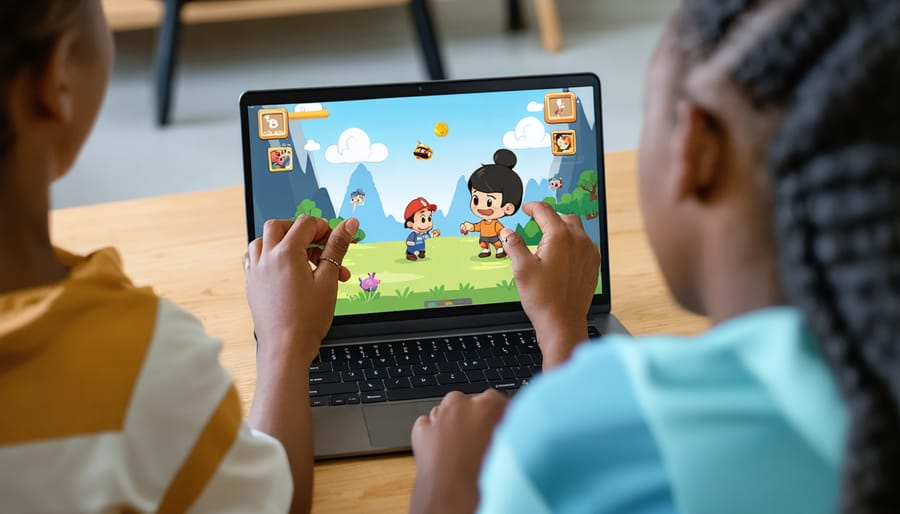E-Learning Games That Actually Make Your Students Want to Review
E-learning games transform your classroom into an interactive learning environment where students actively participate instead of passively absorbing information. Picture your students racing to solve math problems, exploring historical events through immersive scenarios, or building vocabulary while competing with classmates—all while you track their progress in real-time.
These digital tools go beyond traditional worksheets and videos by adding game mechanics like points, levels, and challenges that tap into your students’ natural desire to play and win. The best part? You can customize content to match your exact curriculum needs, whether you’re teaching fractions to third graders or literary analysis to high schoolers.
The difference between e-learning games and other digital resources comes down to engagement and motivation. While educational videos require students to watch and standard quizzes test knowledge, e-learning games create experiences where students learn by doing, failing, and trying again without fear of judgment. This approach works especially well for reaching reluctant learners who struggle with traditional methods, giving you a powerful tool to ensure every student succeeds.
What Makes E-Learning Games Different from Regular Digital Activities
When you hear “e-learning game,” you might picture fancy apps or expensive software, but here’s the great news: the most effective e-learning games for your classroom are often much simpler than that! In the context of game-based learning, we’re talking about teacher-controlled game templates, usually created in PowerPoint or Google Slides, that you can customize to fit your exact lesson needs.
Unlike standalone apps or educational software that run on autopilot, e-learning games put you in the driver’s seat. Think of them as digital game boards where you add your own content, control the pace, and guide your students through the experience. You’re not just pressing play and stepping back—you’re actively facilitating the learning while your students enjoy the gaming elements.
What makes these games special is how they blend the excitement of competition, points, and colorful visuals with your specific learning objectives. A Jeopardy-style template becomes your vocabulary review. A racing game transforms into a math facts challenge. A mystery game turns into a reading comprehension activity.
The beauty is in the customization. You choose the questions, adjust the difficulty, and decide which standards to target. Your students get the motivation boost that comes from gaming elements like scoreboards, timers, and team challenges, while you maintain complete control over the educational content and classroom management.
These aren’t passive activities where students mindlessly click through content. They’re interactive experiences that spark discussion, encourage teamwork, and make review sessions something your students actually look forward to—all while you stay actively involved in guiding their learning journey.
Why Your Classroom Needs Game-Based Review Sessions
The Motivation Factor You’ve Been Missing
Here’s the thing about motivation: your students already have a competitive spirit built in. E-learning games simply give it a productive outlet! When students see points lighting up the screen, hear celebratory sound effects after correct answers, or work together on team challenges, something magical happens. That dreaded review session suddenly feels less like work and more like play.
Think about how your students naturally respond to friendly competition. Game mechanics like leaderboards, badges, and progress bars tap into that same energy. Instead of groaning through flashcards, they’re racing to beat their previous score or collaborating with classmates to unlock the next level. The beauty is that they’re learning the entire time without it feeling like a chore.
These gaming elements transform passive studying into active engagement. A simple point system can turn multiplication practice into an exciting challenge. Team modes encourage peer support and collaboration. Even small touches like sound effects and animations provide instant feedback that keeps students motivated and focused on the content rather than the clock.

When Quiet Students Suddenly Participate
You know that student who always sits quietly in the back, the one who rarely raises their hand? E-learning games have a special way of bringing them into the conversation. When participation happens through a game format, the stakes feel lower and the pressure lifts. Students aren’t putting themselves on the spot in front of everyone—they’re simply playing along with the class.
The magic happens because games create what we call a participation safety net. Wrong answers don’t feel like failures; they’re just part of the game. That shy student who worries about saying something incorrect suddenly feels comfortable taking risks. The anonymity features in many e-learning games let students submit answers without their names attached, which removes that fear of judgment completely.
You’ll notice something wonderful once you start using these games regularly: classroom dynamics shift. Those quiet learners start engaging more, even outside of game time. They gain confidence through small victories and positive reinforcement. The playing field levels because everyone participates at their own pace, without the anxiety of traditional call-and-response methods. Your quietest students might just surprise you by becoming your most enthusiastic participants.
Picking the Right E-Learning Game for Your Lesson
Quick Games for Fast Review
Sometimes you just need a quick energy boost or a speedy review before moving on to the next lesson. That’s where fast-paced games really shine! Quiz-style games work wonderfully for those 10-15 minute slots—think multiple-choice questions that students answer individually or in teams. They’re perfect for morning warm-ups or end-of-class reviews.
Flashcard games are another speedy favorite. Students can zip through vocabulary terms, math facts, or historical dates at their own pace. The beauty here is that you can customize the content to match exactly what you’ve been teaching that week.
Matching games also deserve a spot in your quick-game toolkit. Students pair terms with definitions, images with labels, or questions with answers. These work great on interactive whiteboards or individual devices.
The best part? Most platforms let you create these games in minutes using your existing materials. Just upload your questions or content, choose your format, and you’re ready to go!
Deep-Dive Games for Test Prep
When you have a big test coming up, quick quiz games might not cut it. That’s when deep-dive e-learning games become your secret weapon! These comprehensive formats are perfect for those full-period review sessions where students need to tackle multiple concepts and really show what they know.
Think escape room-style games where students solve progressively harder challenges, or adventure games where they journey through different topics to reach the finish line. These longer formats keep engagement high even during marathon review sessions because they feel like genuine gaming experiences rather than disguised worksheets.
The beauty of deep-dive games is their ability to cover everything without overwhelming students. You can customize these games to spiral through your entire unit, mixing question types and difficulty levels to ensure thorough preparation. Plus, many platforms let you include instant feedback and explanations, so students learn as they play. Your test-anxious students especially appreciate this format because it builds confidence through successful problem-solving in a low-pressure environment that actually feels fun and motivating.
Team Games vs. Individual Challenges
Choosing between team games and individual challenges depends on what you want to achieve in your classroom. Team-based review games work wonderfully when you’re building collaboration skills and want students to learn from each other. They’re perfect for mixed-ability groups where stronger students can support peers, and they create an energetic, social learning environment.
Individual challenges shine when you need to assess each student’s understanding or want to provide personalized practice. They’re ideal for differentiation since students can work at their own pace without peer pressure.
Consider your classroom dynamics too. If competition gets too intense, team formats often feel more supportive. For quieter students who thrive independently, solo challenges might boost confidence. The best part? You can mix both formats throughout the week to keep things fresh and meet different learning needs.

Making E-Learning Games Work in Your Classroom
Your First Game Session Setup
Ready to launch your first game? Let’s walk through it together! Start by browsing your platform’s template library and choose a game format that matches your lesson objective. Quiz-style games work great for review sessions, while adventure games excel at storytelling subjects.
Once you’ve selected a template, click the customize button and add your content. Input your questions, answers, and any images or videos that support your lesson. Don’t worry about perfection—you can always edit later! Most platforms let you preview the game before sharing it with students.
Next, decide how students will play. Will they compete individually, work in teams, or play collaboratively as a class? Set a time limit that fits your schedule, whether that’s 10 minutes for a quick warm-up or 30 minutes for deeper exploration.
Before game day, establish clear expectations with your students. Explain the rules, demonstrate how to navigate the game, and clarify how their performance connects to learning goals. Consider doing a quick practice round so everyone feels comfortable.
Finally, hit that launch button and watch the excitement unfold! Stay nearby to offer guidance and observe how students engage with the material in this fresh, dynamic way.

Keeping the Energy High Without Losing Control
The secret to making review fun with e-learning games is balancing excitement with focus. Start by setting clear expectations before gameplay begins. Explain that enthusiasm is great, but students should use indoor voices and stay seated unless the activity requires movement.
Try using a visual cue system to manage energy levels. Display a traffic light on your screen: green means full energy is okay, yellow signals time to bring it down a notch, and red means refocus time. Students respond well to these non-verbal reminders.
Keep rounds short and purposeful. Five to ten-minute game sessions maintain high engagement without letting chaos creep in. Between rounds, pause to discuss answers or celebrate learning moments. This naturally brings the energy down while reinforcing the educational content.
Consider assigning specific roles within teams, like a captain who reads questions or a recorder who tracks points. When students have jobs, they stay productively engaged rather than getting rowdy. Remember, the goal is excited learners, not overwhelmed ones. With these simple strategies, your classroom stays energized and on track.
Customizing Games to Match Your Teaching Style
One of the best things about e-learning games? They’re incredibly flexible and can bend to fit your unique teaching style and classroom needs. Whether you teach kindergarten math or high school history, these games adapt to you, not the other way around.
Most e-learning platforms offer customizable templates that let you plug in your own content within minutes. You can create multiplication practice games on Monday and vocabulary quizzes on Tuesday using the same game format. PowerPoint game templates are particularly popular because they’re easy to edit and don’t require special software.
The customization options are where the magic happens. Want to add a scoreboard to spark some friendly competition? Done. Prefer collaborative play without points? Simply turn off the scoring feature. You can adjust difficulty levels, time limits, and question types to match your students’ abilities perfectly.
Sound effects and animations can be toggled on or off depending on your classroom environment. Teaching students with sensory sensitivities? Keep things calm and minimal. Have energetic fourth graders who love excitement? Crank up the celebratory sounds and visual effects.
The beauty is that you can create one game and then quickly modify it for different classes or learning objectives. Change the questions, adjust the difficulty, swap out themes, and you’ve got a brand new learning experience. This saves you precious planning time while still giving each class exactly what they need.
Many teachers start with pre-made templates and gradually customize them more as they get comfortable. There’s no pressure to master everything at once. Start simple, experiment, and discover what works best for your students.
Beyond Review: Creative Ways to Use E-Learning Games
E-learning games aren’t just for review time! Think beyond quiz day and explore creative ways to weave games into different parts of your teaching journey.
Start your class with a bang using games as icebreakers. A quick question-based game about student interests or fun facts helps everyone relax and connects classmates in a low-pressure way. It’s perfect for the first week of school or when introducing group projects.
Looking to build team spirit? Turn games into collaborative challenges where students work together rather than compete. Create games where teams must discuss answers before submitting, encouraging communication and problem-solving skills. This works wonderfully for reviewing material before big tests or building classroom community.
Here’s a game-changer: use games for formative assessment throughout your lessons, not just at the end. Pop in a quick five-question game mid-lesson to gauge understanding in real time. The instant feedback helps you adjust your teaching on the spot, and students love the energizing break.
Feeling adventurous? Try games to introduce brand-new topics. Create anticipation by designing a game with intriguing questions that spark curiosity about upcoming lessons. Students make predictions, share prior knowledge, and get excited about what they’re about to learn.
The beauty of e-learning games lies in their flexibility. Experiment with different timing, formats, and purposes. You might discover that a three-minute game transition between subjects keeps energy high, or that exit ticket games provide valuable insight into daily learning. Get creative and watch engagement soar!
Ready to transform your review sessions from groan-worthy to game-on? The best part is, you don’t need to overhaul your entire teaching approach overnight. Start small by choosing just one e-learning game that fits your next unit review. Download it instantly, customize it with your own questions in minutes, and watch how quickly your students perk up when learning feels like play.
The beauty of e-learning games is their flexibility. Whether you have five minutes for a quick warm-up or need a full lesson activity, these games adapt to your schedule and your students’ needs. No complicated setup, no tech headaches, just straightforward fun that reinforces the content you’ve already taught.
Remember, making review enjoyable isn’t just about keeping students entertained—it’s one of the simplest and most effective ways to boost both engagement and learning outcomes. When students are excited to participate, they retain more, perform better, and actually look forward to practice time. So go ahead and give it a try. Your future self will thank you when test scores improve and students actually ask to play again.


